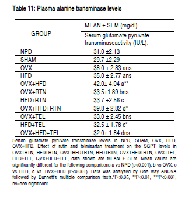Effect of Rutin and Telmisartam on Metabolic Syndrome X
Keywords:
Metabolic syndrome, Peroxisome proliferator activator receptor (PPAR-γ), Diabetic mellitus, Telmisartan, RutinAbstract
The objective of the present study was to investigate the effect of rutin and telmisartan on parameters related with insulin sensitivity, glucose and fat metabolism in the high fructose consumed animal model of the ovariectomized female Sprague dawley rats. Female Sprague Dawley (SD) rats of 180-230 g body weight were grouped and fed with either standard chow diet (NPD) or high fructose diet (HFD30% w/v). Rutin and Telmisartan were administered orally in a dose of 100 mg/kg & 5 mg/kg p.o. Daily for the entire study period. Normal parameters (Food intake & Body weight), Biochemical parameters (Blood glucose by GOD/POD method, Total Cholesterol by CHOD/PAP method, Triglyceride level, LDL, HDL) Metabolic Indicators (Aspartate transminase (AST), Alanine transminase (ALT)), Swimming test, Oral Glucose Tolerance Test, & Body weight were measured in all the groups. The unpaired t- test and analysis of variance (ANOVA) was used for statistical analysis. Telmisartan and Rutin significantly improved abnormal metabolic profile and glucose intolerance. Rutin reduces the body weight, plasma triglycerides, and total cholesterol .in addition rutin reduces the elevated serum glutamate pyruvate transminase levels. Improved abnormal metabolic profile and glucose intolerance indicates that rutin and telmisartan provides a scientific rationale for the use in metabolic syndrome.
References
Reaven GM. Banting 1988. Role of insulin resistance in human disease. Diabetes 37: 1595- 1600.
Sternfeld B, Bhat AK, Wang H, Sharp T, Q 2005. Menopause, physical avtivity, body compositiom/fat distribution in midlife women, Med Sci Sports Exer 37: 1195-1201.
Kamalakkannan N, Prince PSM 2006. Rutin improves the antioxidant status in streptozotocin-induced diabetic rat tissues. Mol Cell Biochem 293: 211-219.
Kurtz T. W et al. 2005. Treating the metabolic syndrome: telmisartan as a peroxisome proliferator activated receptor-gamma activator, Acta Diabetol 42: S9–S16.
Dahlöf B, Burke TA, Krobot K, Carides GW, Edelman JM, Devereux RB, Diener HC. 2004, Population impact of losartan use on stroke in the European Union (EU): projections from the Losartan Intervention for Endpoint reduction in hypertension (LIFE) study. J Hum Hypertens, 18(6):367-73.
Araki K, Masaki T, Katsuragi I, Tanaka K, Kakuma T, Yoshimatsu H 2006. Telmisartan presents obesity and increases the expression of uncoupling protein 1 in diet-induced obese mice. Hypertension 48: 51-57.
Sugimoto K, Qi NR, Kazdová L, Pravenec M, Ogihara T, Kurtz TW., 2006, Telmisartan but not valsartan increases caloric expenditure and protects against weight gain and hepatic steatosis. Hypertension.;47(5):1003-9
Clasen R, Schupp M, Foryst-Ludwig A, Sprang C, Clemenz M, Krikov M, Thöne-Reineke C, Unger T, Kintscher U, 2005; PPARgamma-activating angiotensin type-1 receptor blockers induce adiponectin. Hypertension. 46(1):137-43.
Schupp M, Curtin JC, Kim RJ, Billin AN, Lazar MA. 2007, A widely used retinoic acid receptor antagonist induces peroxisome proliferator-activated receptor-gamma activity. Mol Pharmacol.;71(5):1251-7.
Yamagishi S, Nakamura K, Imaizumi T. 2005, advanced glycation end products (AGEs) and diabetic vascular complications. Curr Diabetes Rev.;1(1):93-106.
Yusuf S. 2002, From the HOPE to the ontarget and the transcend studies: challenges in improving prognosis. Am J Cardiol.; 24;89(2A):18A-25
Mc Cardle, W.D 1967. Metabolic stress of endurance swim-ming in the laboratory rat Journal of Applied Physiology 22: 50-54.
Astrup A, Rössner S, 2000, Lessons from obesity management programmes: greater initial weight loss improves long-term maintenance. Obes Rev.; 1(1):17-9.
Sanders TA. 2003,Food safety and risk assessment: naturally occurring potential toxicants and anti-nutritive compounds in plant foods, Forum Nutr.; 56: 407-9.
Srinivasan K, Patole PS, Kaul CL, Ramarao P. 2004, Reversal of glucose intolerance by by pioglitazone in high fat diet-fed rats. Methods Find Exp Clin Pharmacol.; 26(5):327-33.
Latour MG, Shinoda M, Lavoie JM 2001. .Metabolic effects of physical training in ovariectom- ized and hyperestrogenic rats. J Physiol 90: 235-241.
Larue-Achagiotis C., Martin C., Verger C., Chabert M. & Louis-Sylvestre J 1993. Effects of acute treadmill exercise and delayed access to food on rats Physiolo and Behavior 53: 403-408.
Rodgers PT, Fuke DC. 2006, New and emerging strategies for reducing cardiometabolic risk factors. Pharmacotherapy.;26, 13-31



